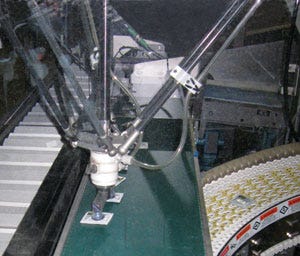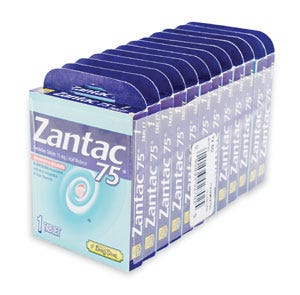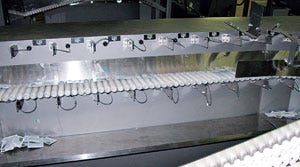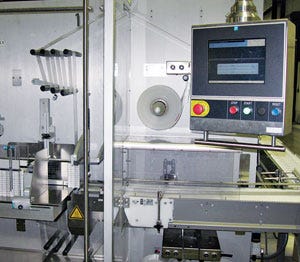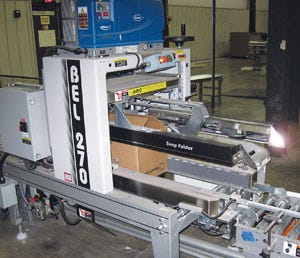|
A new secondary-packaging operation at contract packager CCB Packaging Inc., Cedar Rapids, IA, utilizes pick-and-place robots to precisely place small pouches containing over-the-counter drug products such as Advil, Tylenol and the like, into flighted pockets feeding a cartoner. In addition to the robotic operation, the automated turnkey system, which was supplied by systems integrator, Blueprint Automation, includes the cartoner and a stretch bundler, as well as ancillary equipment.
CCB, which was founded in 1988 to hand-assemble point-of-purchase displays, has grown from an initial staff of 12 employees to more than 100 full-time employees and 150 to 200 contract staff with a 175,000-sq-ft facility. “Our business mainly consists of breaking bulk packs of products into individual packages or variety packs, and a typical operation might have as many as 20 people,” says vp Frank Cotty. “A few years ago, we made the decision to change our focus to contract packaging through automation. That lets us significantly reduce our labor costs and line staffing, while increasing line throughput. This, in turn, affords our customers reduced pricing and higher overall value.”
Backing up its ideas with action, three years ago, CCB purchased an integrated line with six pick-and-place robots from Blueprint Automation. “That was our introduction to Blueprint Automation, but our relationship since then has progressed to a really strong partnership,” says Cotty. “They've enabled us to stretch the envelope in our thinking. With this latest project, we needed to run 62 different products into four carton sizes. We just went to Blueprint with our needs, and they came up with the complete line. They helped us with the installation and startup, and they maintained a full-time person here to adapt the programming based on our operator feedback.”
The new line was installed to run convenience-size packages of OTC products for Lil' Drug Store Products Inc. CCB ran this business from the mid-90s until 2003, but then it lost the business because the equipment could only place one package into a carton, and Lil' Drug wanted multiple packages to be placed into the cartons. The business went to a copacker in Chicago. The new robotic system, which can place multiple pouches per carton, enabled CCB to resecure the contract by reducing the cost per piece for the customer, as well as maintaining the flexibility to run singles, doubles, triple or more pouches into a single carton.
As a result of this system, Lil' Drug signed a multiyear contract with CCB to package the products. “We have had a long, successful partnership with CCB Packaging,��” says Jim Bohnenkamp, director of operations for Lil' Drug Store Products. “I discussed our quality and line-speed requirements with Frank Cotty at CCB, and I was very impressed with the commitment that they are making to automation. The consistent high-quality product at a reasonable cost structure is impressive. A number of different philosophies were reviewed for placing small OTC pouches within cartons, and this is the best solution by far.”
Three robotic workcells
|
The new Blueprint Automation line utilizes three robotic work cells to singulate pouches from bulk and place them in the infeed of the cartoner at a rate of up to 300 bucket loadings/min for the three workcells. Within each workcell, a feeder singulates the pouches and presents them to the robot. The robot utilizes vision guidance to acquire the pouches from a continuously moving conveyor. A vacuum end effector picks and places one, two or three pouches at each robot cycle. Finished cartons are conveyed through a checkweighing system and then on to a bundler. Bundled stacks are then conveyed to a manual case-packing station. The RSC cases are automatically erected and sealed using hot-melt adhesive. “We went from a range of nine to 12 people to run these products for Lil' Drug to four to six people with the new automated line,” says Cotty.
Singulator sections
To start the operation, the pouches are dumped into the feed hopper of a singulating system. The pouches travel up an inclined flighted conveyor and are released on demand onto the singulator, which consists of 14 servo-driven tracking sections. A sensor above each section views the pouches on that section and speeds up or slows down the rollers to separate the pouches. The goal is a separation of about 25 mm when the pouches discharge onto the robotic-pick conveyor, which is running at a right angle to the singulator.
|
A pouch singulator incorporates 14 servodriven sections, each with a dedicated sensor, to separate pouches before they discharge to the robotic-placement operation. |
The pouches travel beneath a Cognex Corp. vision system that looks for the center and the orientation of each pouch on the conveyor. Based on the information from the vision system, the FlexPicker™ IRB360 robot from ABB Inc. descends and picks up one pouch with one vacuum cup and then descends again and picks up the second pouch.
The end effector turns before each pickup so the pouches are oriented properly for placement in the buckets. If two pouches are touching on the conveyor, the robot ignores them and they drop off the end of the robot-pick conveyor into a box and are recycled.
Robot places pouches
The robot swings over and places the two pouches into two adjacent buckets on the cartoner infeed conveyor. A laser sensor looks for the pouches in the buckets, and if each bucket contains a pouch, it signals the second robot to proceed with its placement. When this is completed, another laser sensor checks the buckets to make sure that each bucket contains two pouches and that the pouches are oriented properly for cartoning. A supervisory control system collects and displays important production data.
The buckets then continue into the model SC6 cartoner from Oystar USA. A rotating three-arm suction system picks carton blanks from a magazine with suction hoods and places them into a horizontal carton-transport chain. Plastic fingers on the suction hoods open the cartons as they are being transferred to the chain, which runs parallel to and contiguous with the bucket conveyor.
Pushers with integral holddown blades extend and push the pouches into the cartons as they travel continuously through the machine. The holddown blades ensure that the pouches travel smoothly into the pouches and don't jam. When loading is complete, a sensor inspects the cartons to ensure that they do contain pouches. While the cartons are still in the cartoner and the flaps are still controlled, a Model A200 Plus small-character ink-jet printer from Domino Amjet Inc. applies the lot number and a useby code to one end flap. The end flaps are then sealed with hot-melt glue from a Nordson Corp. ProBlue 4 unit, after which a SickUSA Inc. bar-code scanner verifies that the bar code on the carton coincides with the information in the machine computer, and a Banner Engineering Corp. vision system verifies that the lot and use-by date have have been printed on the carton. Machine setup as well as format data are displayed on a 12-in. color touchscreen operator panel. If errors are found by any of the inspection systems, the machine stops and the problem is corrected manually.
Bundling six or 12 stacks
The pouches pass over a checkweigher from Mettler-Toledo Hi-Speed with an accuracy of 0.5 gm, and then travel to a PEWO Pack-250 compact bundler from Pester Pac Automation USA, which stretch wraps a band around a stack of six or 12 cartons. During PD's visit, CCB was running 12-packs. Because of the fifth panel on the cartons, which have an opening for hanging the cartons on pegs, the cartons then pass through a device that turns them 90 deg on the conveyor so they will be properly oriented for bundling. This enables the bundler to place a stretch band around the sides that don't have the fifth panel.
|
|
After passing over a checkweigher, above, the pouches travel to a compact bundler, top, that wraps a band around a stack of six or 12 cartons. The bundler assembles |
The bundler assembles five stacks at a time. In this operation, five cartons enter the stacking section and spring-loaded siderails lift them up, after which another five enter the section and are lifted. This continues until the stacks are 12-cartons-high, at which point the five stacks are pushed out of the stacking zone.
This group of stacks then enters the subsequent transfer zone in which the five stacks are separated into one-row stacks by an additional drag-type cross-feed pusher. The individual stacks are pushed via the main infeed pusher through the film-wrapping zone, one at a time.
The machine is equipped with two rolls of film, which are spliced together in the stretching section. The infeed pusher moves a stack of cartons through the film curtain, and a closing bar descends and pushes the film downward behind the stack. Simultaneously, a heated-sealing blade rises just above the machine table plane. The sealing blade meets with the rubber sealing profile on the closing bar at the bottom of the stack, and the two sections of film are heat-sealed together. The bottom layer of film travels through a slotted shaft that is mounted cross-wise below the stack and turns to stretch the film to the proper tension, just prior to this seal being made. The amount of tension can be adjusted via the touchscreen HMI to provide the optimal film tightness for each carton.
Print-and-apply labels
|
Stacks of cartons are manually loaded into shippers after which they are conveyed to |
The 12-pack stacks are turned onto their sides as they leave the bundler and pass a print-and-apply system that incorporates a Domino Amjet PCU III printer control unit. The system applies a small label that includes a bar code and other identification. The RSC shipping cases are erected by a Lantech.com, LLC, case erector and are conveyed to a manual station where a worker places the stacks in the station. The filled shippers are conveyed to a Bel 270 hot-melt top sealer from Wexxar Packaging Inc. Both the case erector and the top sealer utilize Nordson Corp. ProBlue 4 hot-melt systems.
The sealed cases pass a Domino Amjet C6000 twin-head ink-jet case-printing system that applies a product name, bar code and other information to the cases.The cases are then manually palletized and stretch wrapped on a Phoenix unit for distribution and shipment to Lil' Drug Stores.
More information is available: |
Banner Eng. Corp., 763/544-3164. www.bannerengineering.com |
Cognex Corp., 508/650-3000. www.cognex.com |
Domino Amjet Inc., 847/244-2501. www.dominoamjet.com |
Lantech.com 502/267-4200. www.Lantech.com |
Mettler-Toledo Hi-Speed, 607/257-6000. www.mt.com/hi-speed. |
Nordson Corp., 770/497-3700 www.nordson.com |
Oystar USA, 973/227-5575. www.oystarusa.com |
Pester Pac Automation USA, 201/327-7009. www.pester.com |
Phoenix, 514/956-1525. www.phoenixwrappers.com/packaging-equipment |
SickUSA Inc., 800/325-7425. www.sick.com |
Wexxar Packaging Inc., 604/930-9300. www.wexxar.com |
About the Author(s)
You May Also Like
